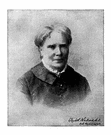Women weren't doctors at this time in history in most countries. In fact, many women didn't go to college at all. Elizabeth was different, however. She had parents who believed that their children should be equal, not divided as boys and girls. Samuel and Hanna encouraged Elizabeth to learn as much as she could, and they helped her attend schools in Europe that gave her a very good education, equal to that of many boys of the day. Her European education was put on hold in 1832, however, when Samuel's sugar business burned down. Like so many other European families at this time, the Blackwells decided to go to America to seek a new life. Samuel Blackwell wanted to start a sugar business, just like the one he had in England. He did so, opening a business in New York; but his ideas on equality extended to African-Americans as well, and he had a very difficult time selling sugar made by slaves. He did it, though, because it was the thing he knew how to do best. He didn't do it long, however; he died in 1837, not long after the family moved to Cincinnati, Ohio. Elizabeth, now 16, went to work as a teacher to help support her family. Her mother went to work also, as the principal of a small elementary school for African-American children.  Elizabeth decided to go to medical school at the urging of a friend who was dying. Elizabeth was rejected by 16 medical schools but was finally accepted by Geneva (New York) Medical College. She studied hard and endured the taunts and meanness of the other students and the people in the college town, and she graduated on January 23, 1849. Elizabeth decided to go to medical school at the urging of a friend who was dying. Elizabeth was rejected by 16 medical schools but was finally accepted by Geneva (New York) Medical College. She studied hard and endured the taunts and meanness of the other students and the people in the college town, and she graduated on January 23, 1849.One of the things she did after receiving her medical degree was travel to Paris, to study more about medicine. While there, she developed an eye infection that cost her sight in her left eye. Undaunted, she continued to study. She returned two years later and opened a school to help other women become doctors and a store where women and children could buy medicine. Both of these were revolutionary ideas, as new and different as the idea of a woman doctor. Elizabeth and her only surviving sibling, Emily, raised money to open a hospital especially for women and children. The New York Infirmary for Women and Children opened in 1857. Of course, it was run by women doctors. It was the first of its kind anywhere in the world. The Blackwells were also involved in the antislavery movement in America, helping to publicize the horrors of slavery. They counted among their friends abolitionists Henry Ward Beecher and Harriet Beecher Stowe. Elizabeth also trained nurses in the Union forces during the Civil War.  The Blackwells built on their success by opening a medical college for women, in 1868. The following year, Elizabeth left Emily in charge of the infirmary and college and returned to England, to repeat her American success there. She did so, with famed Crimean War nurse Florence Nightingale (right), opening the Women's Medical College. The Blackwells built on their success by opening a medical college for women, in 1868. The following year, Elizabeth left Emily in charge of the infirmary and college and returned to England, to repeat her American success there. She did so, with famed Crimean War nurse Florence Nightingale (right), opening the Women's Medical College.She continued to champion women's rights, especially in the growing movement for women's right to vote. Her friends and extended family members included suffrage movement leader Lucy Stone. She died on May 3, 1910, having made a name for herself as the first female doctor in America but also as a champion for women's rights in Europe and elsewhere. She is forever remembered as the namesake of the Blackwell Medal, established in 1949 and given to women with outstanding achievements in the field of medicine. |
|
Social Studies for Kids
copyright 2002–2026
David White


